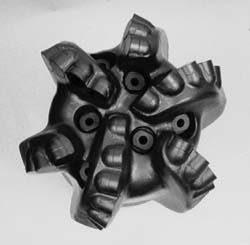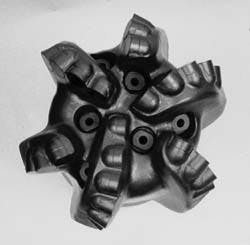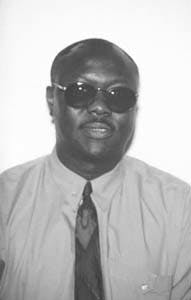NEW PDC BIT DESIGN REDUCES VIBRATIONAL PROBLEMS
Graham Mensa-Wilmot, Will L. Alexander,
Smith International Inc.
Houston
A new polycrystalline diamond compact (PDC) bit design combines cutter layout, load balancing, unsymmetrical blades and gauge pads, and spiraled blades to reduce problematic vibrations without limiting drilling efficiency. . Stabilization improves drilling efficiency and also improves dull characteristics for PDC bits. Some PDC bit designs mitigate one vibrational mode (such as bit whirl) through drilling parameter manipulation yet cause or excite another vibrational mode (such as slip-stick). A vibration-reducing design should not impose bit limitations and should not confine a bit's range of operational parameters (weight on bit, rotational speed, etc.).
The identification of vibrations as the major form of PDC bit failure has had significant influence on bit design and development. Although axial, torsional, and lateral vibrations were the first to be recognized, the identification and understanding of bit whirl has also drastically influenced PDC bit performance.
To prevent or mitigate PDC bit vibrations, several methods have been tried by various bit manufacturers. Some of these vibration-reducing features and concepts, however, place design and operational limitations on the bit, resulting in the inefficient use of the mechanical energy available to the bit. These limitations also affect the ease with which vibrations are mitigated once they occur.
An alternative vibration-reducing concept which places no limitations on the operational environment of a PDC bit has been developed to ensure optimization of the bit's available mechanical energy.
PDC bits were originally thought to have applications only in soft, medium soft, and medium formations. The applications envelope of PDC bits has recently been extended into harder formations because of technological innovations. The basis for some of these improvements has been the requirement for these types of bits to be stable.
BIT STABILIZATION
Stabilization improves PDC bit performance through the efficient use of available energy and improved dull bit characteristics. The total energy available to a bit can be divided into two components, in terms of drilling and vibrating (Equation 1) (30514 bytes). With respect to drilling efficiency, the lower the vibratory portion of the total available energy, the higher the drilling component, and vice versa. Bits with high drilling energy components use the available energy well and have higher drilling efficiencies (Equation 2) (30514 bytes).
The performance of a bit (BP) can be represented by Equation 3, as a function of penetration rate and dull grade. Although Equation 3 (30514 bytes) looks simplistic, it establishes a bit's mechanical behavior. A bit's rate of penetration (ROP) can, in turn, be expressed as a function of its DG, or dull grading (Equation 4) (30514 bytes). The combination of Equations 3 and 4 results in the redefinition of BP as Equation 5 (30514 bytes).
The vibrational characteristics of PDC bits are established by their design, whereas the impact loads associated with these vibrations are dependent on the strengths of the formations being drilled. Stable bits have minimized vibratory components (Ev), thereby reducing the potential for the cutting elements to experience premature failure. The dull characteristics are thereby improved, enabling the cutting elements to remain sharper and stay in a shearing mode longer. In actuality, BP and DG exhibit an inverse relationship (Equation 6) (30514 bytes).
VIBRATION REDUCTION
To combat PDC bit vibrations, much effort has been put into designing and developing stable bits. The term "antiwhirl" has become synonymous with the low-friction gauge pad concept. Bits with this technology are designed with a high imbalance force directed towards a low-friction gauge pad. During off-center rotation, the imbalance force pushes the bit's low-friction pad against the borehole wall. This action prevents the bit from pivoting and rotating about a point on its gauge, which otherwise would have resulted in bit whirl.
Although this concept has been successful in reducing the occurrence of bit whirl, it has not been able to extend the application envelope of PDC bits. Also, the limitations this concept places on bit design have often resulted in bits with weaker shoulder and gauge areas. To be effective, this concept requires a restriction in a bit's operational parameters (high weight on bit, low rotational speed) which often may not represent the optimum conditions for the bit or drilling application.
Other known vibration-reducing features include force balancing, long and large gauge pads, flat profiles, deep cone angles, cutter edge geometry, and stabilizers. These features have had measurable amounts of success without seriously attacking the broad topic of PDC bit vibrations.
The understanding of PDC bit vibrations has resulted in the recognition of some generalizations that have long been overlooked by industry:
- Bit whirl is only one of four types of vibrations that a PDC bit may experience, and it is the most severe.
- All the different types of vibrations require different mediums for their initiation and propagation.
- The conditions for the mitigation of one type of vibration may easily establish the environment in which another form of vibration flourishes.
It has been proven both in the laboratory and in the field that the conditions required for mitigating bit whirl are identical to those in which bit-induced torsional, or slip-stick, vibrations prevail. It is therefore difficult for a technology, whose efficiency is dependent on specific operational parameters, to be effective at stopping all types of PDC vibrations.
VIBRATION PREVENTION
A new approach to the prevention or mitigation of PDC bit vibrations places no requirements on operational parameters. This new technology thus ensures the establishment of an optimum operational parameter regime for a PDC bit without compromising the bit's vibration-reducing efficiency.
The new concept for reducing PDC bit vibrations involves the integrated use of cutter arrangement, load balancing, unsymmetrical blade layout, and a spiraled blade and gauge design. These features together help prevent vibration initiation or mitigate the damaging effects of these vibrations once they start.
CUTTER ARRANGEMENT
The "plural" cutter arrangement places groups of cutting elements in concentric rings at specific radial positions on the bit's face (Fig. 1) (40773 bytes). This deployment establishes an uneven bottom hole pattern, which creates ridges of formation in between adjacent concentric rings.
Cutters in identical radial positions (groups) follow each other in valleys. At the initiation of off-center rotation, the cutting elements bite into the adjacent ridges of formation. This action creates a stabilizing force in a direction opposite to that in which the bit is being offset, which re-establishes its true center rotation (Fig. 2) (40126 bytes).
The stabilizing force lies in a plane perpendicular to the bit's axis and is defined by Equation 7 (30514 bytes).
LOAD BALANCING
Load (force) balancing is the most popular of all the methods that have been tried to eliminate or reduce PDC bit vibrations. Although it is generally accepted that PDC bits should be force balanced, there is no uniform definition on what constitutes a force-balanced bit nor how the balancing should be achieved.
In their shearing action, PDC cutting elements generate forces that act both parallel to and on a plane perpendicular to the bit's axis. The magnitudes and directions of these forces depend on the strength of the formation being drilled and on the bit's operational parameters. The dependence of these forces on the bit's design parameters can be represented by Equation 8 (30514 bytes).
The vector summation of the forces found in the plane yields a net imbalance force. This imbalance force, depending on its magnitude and the process by which it is achieved, can cause a PDC bit to be offset from its geometric center.
A special balancing process is used in this new vibration reducing concept that reduces the magnitudes of the forces on the bit, which reduces cutting-action-induced bit vibrations.
BLADE LAYOUT
A PDC bit's design philosophy characterizes the types of vibrations it encounters. In a suitable environment, these vibrations build up energy levels that tend to sustain and amplify their frequency and magnitudes, respectively. Although the intent is to prevent the initiation of these vibrations, this objective is sometimes difficult to achieve. A stable-bit concept requires designs to dampen the vibrations if they occur.
An unsymmetrical blade layout is one vibration-reducing design that breaks up the periodicity required to sustain and amplify PDC bit vibrations. In this arrangement, the angles between the blades on the bit's face are made unequal (Fig. 3) (38124 bytes).
SPIRALED BLADES
The magnitudes of the forces presented by spiral blades in a direction perpendicular to the borehole wall are lower than those of comparable straight blades. These lower forces reduce the stresses on the bit's gauge at the bit/borehole wall interface, thereby minimizing the potential for the bit to pivot and rotate about points on its gauge.
A spiraled gauge pad presents a longer circumferential contact between a bit and the borehole. This (Fig. 4) longer contact increases the time during which the gauge of a bit, that is offset from its geometric center of rotation, stays in contact with the borehole. For identical gauge forces and bit rotational speeds, this longer time decreases the stresses on the bit's gauge. Lower stresses reduce the potential for the bit to pivot about points on its gauge.
BIT DESIGN
The vibration-reducing concept is most effective when all four designs are used together. The specificity of the balancing process, its methodology, and the requirements imposed on the forces on the bit reduce the potential for the bit to be offset from its geometric center of rotation. In instances where a bit with this vibration-reducing concept experiences an offset from its true center, the stabilization forces created by the plural cutter arrangement re-establish the bit's true center of rotation. These two designs work to prevent the initiation of PDC bit vibrations.
The spiraled blades and gauges reduce the stresses required to establish pivot points on the bit's face and gauge. This condition becomes a major requirement in situations where the vibration prevention features are unable to re-establish the true center of rotation. The unsymmetrical blade layout disrupts the environment required to sustain any forms of vibration the bit might experience. These two features of the concept mitigate the potential for a PDC bit to build up on its cutting-action-induced vibrations.
This vibration-reducing concept places no limitations on a bit's design, which permits a bit's development to be linked to the drilling application and operational conditions. In addition, the concept does not restrict operational parameters. Attempts to mitigate a specific vibrational mode (bit whirl) by varying weight on bit or rotary speed does not cause the bit to be excited in another vibrational mode (slip-stick).
ACKNOWLEDGMENT
The authors thank Smith International Inc. for permission to publish this article and John Simmons and Diane Jordan for their contributions.
BIBLIOGRAPHY
Brett, J.F., Warren, T.M., and Behr, S.M., "Bit Whirl A New Theory of PDC Bit Failure," Society of Petroleum Engineers paper 19571, October 1989.
Vandiver, J.K., Nicholson, J.W., and Shyu, R.J., "Case Studies of Bending Vibrations and Whirling Motion of Drill Collars," SPE Drilling Engineering, December 1990.
Warren, T.M., Brett, J.F., and Sinor, L.A., "Development of Whirl Resistant Bits," SPE paper 19572, October 1989.
Alexander, W., Pool, R., and Hamm, G., "How to Optimize Motor Drilling in Non-Deviated Wells," Petroleum Engineer International, February 1994.
Mensa-Wilmot, G., "PDC Bits Boost CT Drilling Efficiency," American Oil and Gas Reporter, January 1995.
Langveld, C.J., "PDC Bit Dynamics," SPE paper 23867, February 1992.
Sinor, L.A., and Warren, T.M., "Application of Anti-Whirl Bits Gains Momentum," SPE paper 25644, April 1993.
Mensa-Wilmot, G., and Coolidge, R., "Coiled Tubing Drilling With Specialized PDC Bits," SPE paper 27438, February 1994.
Alexander, W., "Advancing Bit Technology Saves Time and Money: A Case History," Drilling Contractor, September 1994.
Glowka, D.A., and Stone, C.M., "Thermal Responses of Polycrystalline Diamond Compact Cutters Under Simulated Downhole Conditions," Journal of Petroleum Technology, April 1985.
THE AUTHORS
Mensa-Wilmot has been involved in engineering and developing PDC bits, mostly researching the identification and mitigation of their vibrational characteristics. He has broad experience in PDC bit applications.
Copyright 1995 Oil & Gas Journal. All Rights Reserved.



